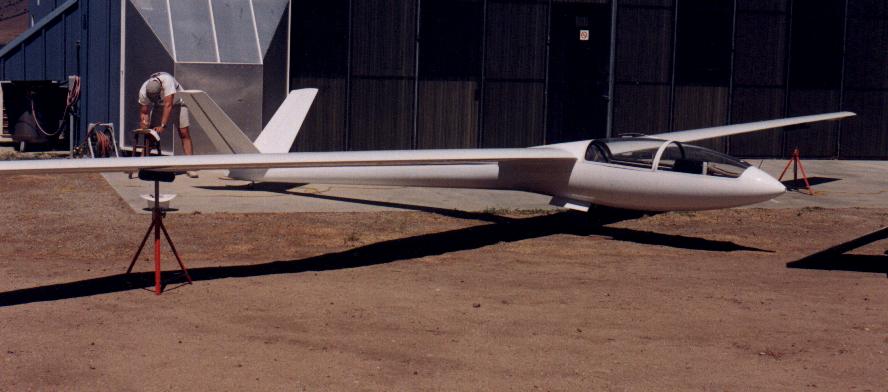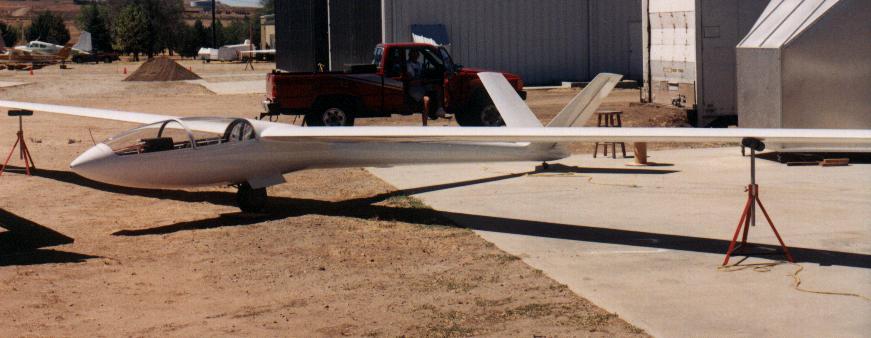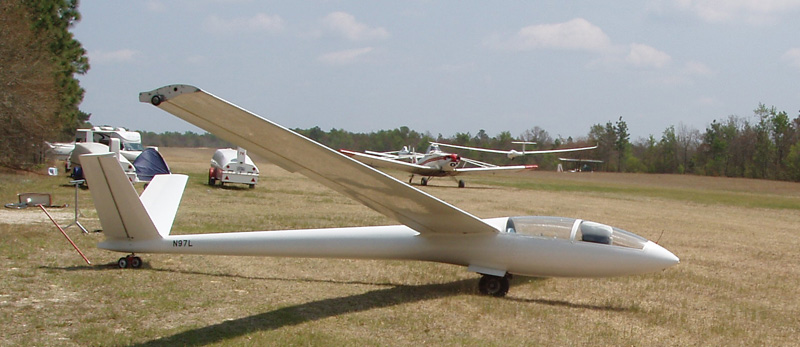
November Niner-Seven Lima Flies Again
by
Marc Whisman
A year and a half has past since I read the ad in Sailplane Builder, the newsletter of the Sailplane Homebuilders Association: "HP-18 Project, no time to repair my own HP." "Fly a 40/1 glider..."
Huh? 40/1? I called the number, it was Dan Armstong who I already knew from the SHA. He have me the run down on the ship: On the last flight it sustained minor damage from a gear collapse at 5 MPH as he was rolling out after landing. I started checking into the HP as I knew absolutely nothing about it. Designed by Dick Schreder to be competitive in the 15 meter class, the HP-18 was the most popular sailplane kit in terms of numbers sold. There are currently about 50 in the US according to the Sailplane Directory. Specs are 49.2 foot span, 113 sq ft of area, and min sink of 1.8 fps @ 43 kts.
Looks good so far, so I start talking to people to get a feel for the glider; bad habits, cautions etc. Probably the most common thing I was told was that itís not for a low time pilot. Iím not exactly low time, but my glider experience has been limited to Schweizer stuff.
A few weeks pass and I finally get up to Tehachapi to see it. Itís in a workshop, and the paint has been stripped to make repairs. The panel is out, the tail feathers off, and itís basically just a shell. Boxes contain all the parts, and Dan goes over the various aspects of what he was doing and why. Iím overwhelmed. Iíve taken on big projects before, but I usually knew something about them, or at least could find specific books on things.

This was way different, so I check in with my friend and neighbor Jim Wolf. Jimís a member of the EAA chapter 7 at Long Beach, and at the time he owned Ĺ interest in the Standard Class Discus, Hotel Whiskey. He also built a Kitfox in his garage. If anyone would know what I was getting into it would be him. He readily agrees to take a look at the HP and flies his Kitfox up to Tehachapi during the SHA workshop last year on Laborday. After a couple of hours looking things over, he gives me the nod, says heíll help, and I give Dan a deposit.
Various projects get in the way at home, but I finally drive up with Jim a few months later to pick it up. Dan had put new tires on the trailer and had the bearings repacked to ready it for the trip.
I get it home, but I still wait until Iím ready to devote some time to it before we finally get started.
|
Next we finished the gear doors that Dan had started. After working out the problems there, we take everything back out of the fuselage again for the umpteenth time to have it painted. We alodyne the metal, sand until we canít take it any more, and ship it off to the guy thatís going to paint it.
It would be almost a month before I see it again.
Finally the call comes: "Your glider is ready to be picked up." Jim goes with me to get it, and as we walk in the hanger at Whiteman Airport, Iím taken back. Itís beautiful! What a change from the way I first saw it! We load it in the trailer and bring it home. Now the real work starts. Slowly, piece by piece we add the parts again to make it complete. First the landing gear, being careful not to scratch the paint. Then the gear doors. A few problems arise that we work out as we go, but as the days wear on, it begins to look more and more like a sailplane. We rebalance the ruddervators on the V tail, mount the movable to the fixed surfaces, and refit the two-part canopy to the glider. I install the panel, get the chute repacked, have an annual done and re-weigh the ship to compute the weight and balance. Finally itís ready to be test flown.

I had already arranged for Dan to do the test flight as he was familiar with the ship and would be able to tell if there were any problems. On 7 Sept 97, I take it back to Tehachapi and meet with Dan. We assemble the glider, tape all the joints, I put on the "N" numbers and November Niner-Seven Lima is ready for itís first flight since 21 Feb 93. We push it out to the line and the line boy hooks up the rope. Dan wags the rudders and as the Pawney applies power, he rolls down the runway. He takes a 2000 foot tow but doesnít find any lift and comes back a few minutes later. A pattern tow this time and itís my turn if I want. I think about it. The day is getting long, and Iím at a strange airport with a plane I havenít flown before. If thereís one thing I learned in hang gliding, itís that you only change one thing at a time. I decline.
We pull it apart and I head back for Long Beach. Another 2 weeks pass and I finally feel Iím ready. On 21 Sept 97 at Lake Elsionoreís Skylark airport I put on the chute, push Niner-Seven Lima to the line and get in.
After a few minutes to adjust things, I signal the tow plane Iím ready and Curly pulls it into position. Iíll be the last tow of the day, and everyone at the Lake Elsinore Soaring club is out to watch. I wag the rudders, and my good friend Curly applies power.
Holding the flaps negative, I let the speed build until I feel I have good control. I lower the flaps and the HP jumps into the air. Following Curly, I take a full tow followed by a soft release. A right turn and Iím on my own. As I settle in, I play with the controls to get the feel but somethingís different - this is one slippery ship! I lose some altitude before I find a late afternoon thermal. It takes some getting used to, but Iím able to extend my flight for 45 minutes and only had one incident where I got too slow with a bit too much rudder in a turn. Whoa! I wonít be doing that again! Iím sure glad I had that aerobatics training.
|
As the lift falls off, I head back to the airport for the show. Arriving high on base, I crank in the flaps and point the nose down. I get to the threshold at about 30 feet and holding 60 knots. As I sink lower, I roll some of the flaps off knowing Iíll be long but choosing to take my time as opposed to rushing things. As I pass the office the "critics" are out in force. I level off and start bleeding speed, and the HP starts to eat the 2500 foot runway for dinner. Finally she settles in to a nice touch down and roll out. I pop the canopy, flip open the belts and jump out. The others can see my grin from the other end of the runway.
Dave arrives with the truck to tow me back and as I walk in the office for beer-thirty, high fives and congratulations ring out.
November Niner-Seven Lima Flies Again!
Special thanks to Jim Wolf, Bill Berle, Larry Perkins, Roy Van Raden, Dan Armstrong, Kevin Perry, Rex Sweetland and Curly for all of their help and support. And of course Special Thanks to my wife Rita for putting up with me through the last trying months.

Photo taken by Claude Chapman, Perry, SC May 2007.